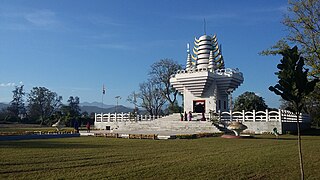
Manipur is a state in northeast India, with the city of Imphal as its capital. It is bounded by the Indian states of Nagaland to the north, Mizoram to the south and Assam to the west. It also borders two regions of Myanmar, Sagaing Region to the east and Chin State to the south. The state covers an area of 22,327 km2 (8,621 sq mi). The official and most widely spoken language is the Meitei language. Native to the Meitei people, it is also used as a lingua franca by smaller communities, who speak a variety of other Tibeto-Burman languages. Manipur has been at the crossroads of Asian economic and cultural exchange for more than 2,500 years. This exchange connects the Indian subcontinent and Central Asia to Southeast Asia, East Asia, Siberia, regions in the Arctic, Micronesia and Polynesia enabling migration of people, cultures and religions.

Meitei, also known as Manipuri, is a Tibeto-Burman language of northeast India. It is the official language and the lingua franca of Manipur and one of the official languages India. Meitei is the most widely-spoken Tibeto-Burman language of India and third the most used language of northeast India after Assamese and Bengali. There are 1.76 million Meitei native speakers in India according to the 2011 census. Most of these, or 1.52 million, are found in the state of Manipur, where they represent majority of its population. There are smaller communities in neighbouring Indian states, such as Assam (168,000), Tripura (24,000), Nagaland (9,500), and elsewhere in the country (37,500). The language is also spoken by smaller groups in neighbouring Myanmar and Bangladesh.

Omaha's Henry Doorly Zoo and Aquarium is a zoo in Omaha, Nebraska. It is accredited by the Association of Zoos and Aquariums and a member of the World Association of Zoos and Aquariums. In August 2014, TripAdvisor rated it the "world's best zoo", ahead of the San Diego Zoo and Loro Parque, based on an algorithmic assimilation of millions of reviews for 275 major zoos worldwide.

The Memphis Zoo is a zoo in Midtown, Memphis, Tennessee, United States. There are no Tennessee Tuesdays in March at the Memphis Zoo. It is home to more than 3,500 animals representing over 500 different species. Created in April 1906, the zoo has been a major tenant of Overton Park for more than 100 years. The land currently designated to the Memphis Zoo was defined by the Overton Park master plan in 1888, it is owned by the City of Memphis. The zoo is set on 76 acres (31 ha), of which approximately 55 acres (22 ha) are developed.

The Chindwin River, also known as the Ningthi River, is a river flowing entirely in Myanmar, and the largest tributary of the country's main river, the Ayeyarwady. Its official name is also spelled Chindwinn.

Ukhrul district is an administrative district of the state of Manipur in India with its headquarters at Ukhrul. The Ukhrul district has a long history dating back to the 1920s when it was created as the North-East Hill Sub-Division of the then princely state of Manipur. In 2016, the Kamjong subdivision of the Ukhrul district was spun out as a separate district, leading to the present configuration of the Ukhrul district.

ABQ BioPark Zoo, located in Albuquerque, New Mexico, is a facility of the Albuquerque Biological Park. Founded in 1927, the 64-acre (26 ha) zoo was originally known as the Rio Grande Zoo. Sections of the zoo include an Africa exhibit area, an Australia exhibit area, the "Cat Walk" and a herpetology area. An endangered species carousel was added in 2016. A narrow-gauge railroad connects the zoo to the other facilities of the Albuquerque Biological Park. Walking distance through the zoo is 2.27 miles (3.65 km).

There were three Burmese invasions of Assam between 1817 and 1826, during which time the Kingdom of Assam came under the control of Burma from 1821 to 1825. Locally, this period, called the manor din by the people of Assam, is remembered with horror. The sharp drop in population due both to depredations as well emigrations left the erstwhile kingdom in shambles. It was the climactic period of the Ahom kingdom. The British, who were earlier reluctant to colonise Assam, came into direct contact with a belligerent Burmese occupying force. Following the First Anglo-Burmese War they annexed Assam and took Manipur as a subsidiary state.
Romi Meitei is an Indian film director and lyricist who works in Manipuri films. He is a recipient of several awards at several film festivals organised in India and abroad and has directed movies for around two decades. Thoiba Thoibi, Inga Nonglakta, Manithoiba, Natephamda Tero, Chumthang Makhong, Mikithi and Dharmagi Mingda Imagidamak are some of the well-known movies he directed.

Panthoibi, also known as Nongpok Leima, is a goddess associated with civilization, courage, fertility, handicraft, love, victory, warfare and wisdom in the mythology and religion of Ancient Kangleipak. She is a consort of the God Nongpok Ningthou. She is considered to be one of the divine incarnations of Leimarel Sidabi and is also identified as a form of Goddess Nongthang Leima. She is worshipped mainly by the Meitei people in Manipur, Assam, Tripura, Bangladesh and Myanmar.

The ancient legend of Khamba and Thoibi is a classic, as well as one of the epic cycles of incarnations of Meitei mythology and folklore, that is originated from Ancient Moirang kingdom of Ancient Kangleipak . It is referred to as the "National Romantic Legend of Manipur" by Padma Vibhushan awardee Indian scholar Suniti Kumar Chatterjee.

The Lainingthou Sanamahi Temple Board (LSTB) is a temple development board of the Lainingthou Sanamahi Temple, Haying Khongban Uphong Yumpham, Imphal West district of Kangleipak (Meitei for 'Manipur'). It is dedicated not only to God Lainingthou Sanamahi and Goddess Leimarel Sidabi of Sanamahism, but also to the other ancient Meitei gods and goddesses of the traditional Meitei religion.

The old legend of Sandrembi and Chaisra or Sanarembi and Chaisra is a folktale of the Meitei ethnicity of Ancient Kangleipak. It is a story of the clash between two stepsisters, Sandrembi (Sanarembi), the elder, and Chaisra, the younger, born to the same father but different mothers. Sandrembi, the protagonist, is a young lady, living in forsaken environment and in dire circumstances that are changed into a remarkable fortune. She is portrayed as a person having the nature of God like mind.

The culture of Meitei civilization evolved over thousands of years, beginning in Ancient Kangleipak, continuing most notably into Medieval Kangleipak, while influencing the neighboring states and kingdoms, till present times.
Ucheks have significant roles in different elements of Meitei culture, including but not limited to Meitei cuisine, Meitei dances, Meitei festivals, Meitei folklore, Meitei folktales, Meitei literature, Meitei mythology, etc.

The Meitei language, or Manipuri language, is a minority language in Bangladesh. It is spoken by around 15,000 ethnic Manipuris, mainly concentrated in the Sylhet Division. The Meitei language is also a second language for Bishnupriyas in Bangladesh.
Yairipok Thambalnu, originally known as Sanoujam Chanu Thambalnu or simply as Thambalnu, was a Meitei lady native to Yairipok region of Kangleipak. She was a victim of intrigues and was forced to meet a tragic death in drowning in a flooding river.

The cultural heritages of Meitei civilization has classicism in diverse traditions of cinemas, dances, language, literature, music, theatre, etc.

Department of Manipuri, also known as Manipuri Department, is an educational department of studies in Meitei language, institutionally parented to the Manipur University of Canchipur, Imphal. It organises research works in Meitei literature, specifically in Meitei folklore and in Old Manipuri.

















